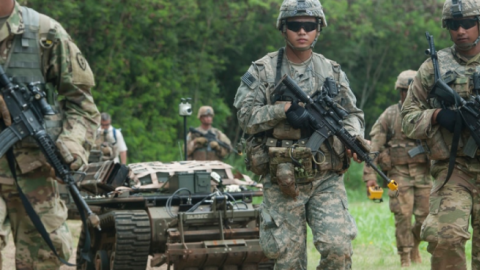p(firstLetter). Almost no one, it seems, is happy with the Biden administration’s first defense budget For progressives, its slight funding cut was not deep enough. For analysts, think tankers and former defense officials on the other side, Pentagon spending should grow at least 3 percent per year to address rising challenges from China, Russia and other bad actors. Neither side is right.
Smaller Department of Defense budgets will require shrinking the force and America’s commitments to allies. But more money will not restore the U.S. military’s edge against other major powers — and may simply reinforce the futurism that let U.S. forces fall behind in the first place.
Outgoing U.S. Indo-Pacific Command leader Adm. Phil Davidson noted earlier this year that China will be in a position to credibly threaten Taiwan, Japan or other U.S. allies before the end of this decade. Pouring additional billions of dollars into cutting-edge ships, aircraft and weapons will not yield results until the 2030s and probably later if current DoD programs are any indication.
Deterring Beijing will therefore require combatant commanders to innovate and do more with the platforms and systems they can field today rather than waiting for a theoretical future force.
The DoD largely missed its window to gain durable advantages against China or Russia during the last 20 years of war in Iraq and Afghanistan. The U.S. military now exits those conflicts with only modestly improved technologies compared to what was being fielded in 2000, requiring U.S. forces to implement concepts that rely less on overmatch and more on adaptability to gain temporary advantages over peer adversaries.
The building blocks of a more adaptable force are available. During the last two decades, government and industry researchers developed a wide range of new sensors, countermeasures, autonomous aircraft and vessels, and command-and-control systems. However, most of these innovations are not distributed throughout the military: They sit in labs or warfare centers to be rolled out for demonstrations or visiting dignitaries but are doing nothing to make Chinese or Russian leaders think twice about their next foreign adventure. And even when new technologies transition, they are shackled to multiyear-long operational cycles. For example, the Navy’s newest networks and electromagnetic warfare systems are only being introduced on fewer than a dozen of its 300 ships each year.
To get the most value from a small number of new platforms or systems, the DoD should ensure they are deployed to the priority theater for that system and remain there.
For instance, unmanned surface vessels would be more useful in the Indo-Pacific region than Europe, whereas mobile short-range air defense vehicles may be best used in Europe or the Middle East. Combatant commanders will therefore need organizations, processes and authorities to integrate these new technologies with the platforms and troop formations already in or deploying to their theater.
Congress and the DoD already identified the need for combatant commanders to assemble forces beyond the generic one-size-fits-all force packages provided by the military services. The European and Indo-Pacific deterrence initiatives show that combatant commanders and their domain-centered component commanders should be equipped to reconfigure and integrate new force compositions that respond to changing adversary tactics and systems, or create new challenges for an opponent.
Without the assured overmatch U.S. forces enjoyed during their post-Cold War conflicts, combatant commanders will need to rely on improvisation and unpredictability to gain a decision-making advantage and deter potential aggressors like China.
When re-composition alone does not provide an advantage, combatant commanders should be empowered to work with service and agency capability developers to adapt current weapons, mission systems, ships and aircraft. Evolutionary development, led by combatant commanders, would enable new technologies sitting on the shelf to reach the force and make a difference in deterring aggression, rather than gradually being dispersed to the entire military.
Congress could help combatant commanders gain a greater role in force composition and mission integration. The rapid capability-development organizations and software factories that could help combatant commanders augment or adapt fielded forces are already in place but require advocates in the Pentagon to implement capability adaptation using funding organized around missions instead of programs.
The combatant commanders will also need the in-theater operational infrastructure of communications, logistics, training and protection capabilities — as requested in the European and Pacific deterrence initiatives — to support mission integration.
The Pentagon should not give up on future weapons and platforms, but innovations delivering in the 2030s or 2040s will be irrelevant if U.S. forces fail to prevent Chinese or Russian aggression during the next decade. With the window of potential Chinese adventurism now opening, Pentagon leaders must accept they missed their opportunity to maintain a persistent military advantage and focus on doing the most with the force they have. Enabling theater commanders to compose and integrate forces is the best approach to create the adaptability and complexity that could deter aggression.




















